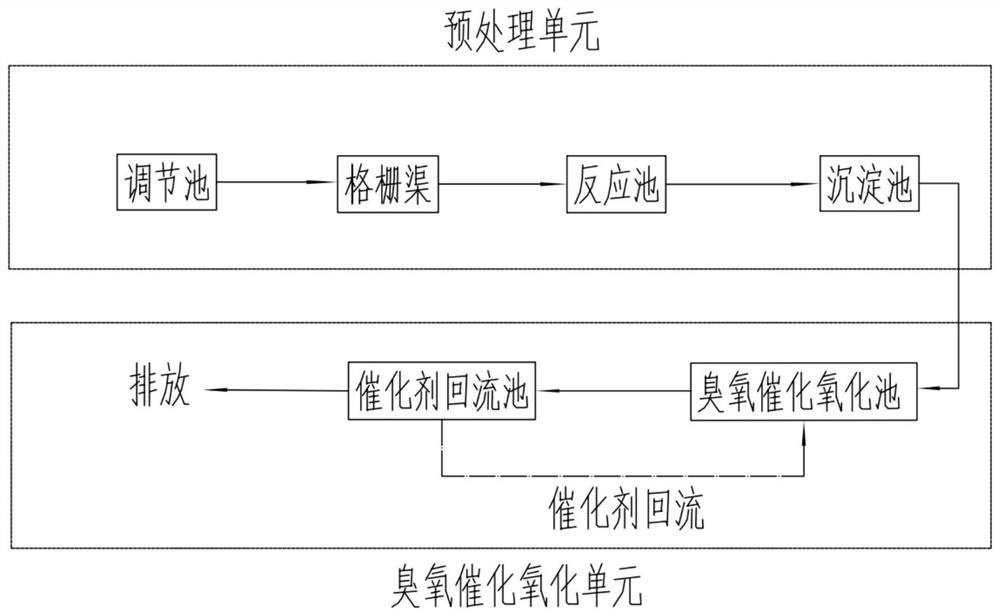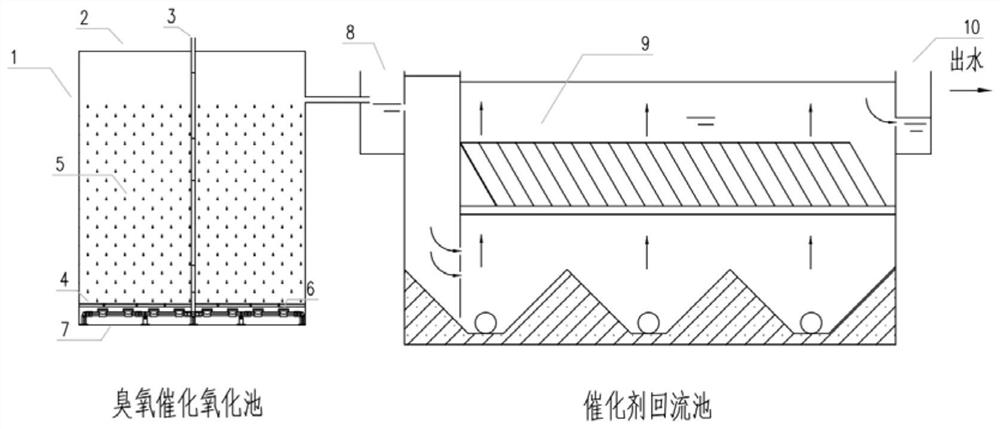Catalyst for inorganic ammonia nitrogen wastewater and wastewater treatment process
A treatment process and catalyst technology, applied in the direction of oxidized water/sewage treatment, multi-stage water/sewage treatment, water/sludge/sewage treatment, etc., can solve the problems of restricting large-scale use of inorganic ammonia nitrogen wastewater treatment, and achieve unit design Perfect, good catalytic stability, not easy to lose effect
- Summary
- Abstract
- Description
- Claims
- Application Information
AI Technical Summary
Problems solved by technology
Method used
Image
Examples
Embodiment 1
[0041] The catalyst preparation process is as follows:
[0042] Step 1: Choose a carrier
[0043] Select water-quenched slag of 100-400 mesh as the catalyst carrier, preferably water-quenched slag of 200 mesh or more;
[0044] The second step: prepare 3.5% Mg2+ magnesium nitrate solution
[0045] According to the percentage by weight, the proportion of magnesium nitrate hexahydrate above industrial grade is 35-40, and water is 60-65;
[0046] Step Three: Dipping
[0047] Immerse the catalyst carrier in the magnesium nitrate solution for more than 4 hours to load the magnesium on the surface of the carrier;
[0048] Step Four: Dry
[0049] Take out the catalyst carrier from the magnesium nitrate solution, dry it at room temperature, put it into an oven, and dry it at 100-120°C for more than 12 hours;
[0050]Step 5: Roasting
[0051] Put the above-mentioned dried catalyst carrier into a furnace, and bake it at 400°C for 4 hours to obtain the MgO-based catalyst;
[0052] ...
Embodiment 2
[0054] The catalyst preparation process is as follows:
[0055] Step 1: Choose a carrier
[0056] Select water-quenched slag of 100-400 mesh as the catalyst carrier, preferably water-quenched slag of 200 mesh or more;
[0057] The second step: prepare 3.5% Mg2+ magnesium nitrate solution
[0058] According to the percentage by weight, the proportion of magnesium nitrate hexahydrate above industrial grade is 35-40, and water is 60-65;
[0059] Step Three: Dipping
[0060] Immerse the catalyst carrier in the magnesium nitrate solution for more than 4 hours to load the magnesium on the surface of the carrier;
[0061] Step Four: Dry
[0062] Take out the catalyst carrier from the magnesium nitrate solution, dry it at room temperature, put it into an oven, and dry it at 100-120°C for more than 12 hours;
[0063] Step 5: Roasting
[0064] Put the above-mentioned dried catalyst carrier into a furnace, and bake it at 400°C for 4 hours to obtain the MgO-based catalyst;
[0065]...
Embodiment 3
[0067] The catalyst preparation process is as follows:
[0068] Step 1: Choose a carrier
[0069] Select water-quenched slag of 100-400 mesh as the catalyst carrier, preferably water-quenched slag of 200 mesh or more;
[0070] The second step: prepare 3.5% Mg2+ magnesium nitrate solution
[0071] According to the percentage by weight, the proportion of magnesium nitrate hexahydrate above industrial grade is 35-40, and water is 60-65;
[0072] Step Three: Dipping
[0073] Immerse the catalyst carrier in the magnesium nitrate solution for more than 4 hours to load the magnesium on the surface of the carrier;
[0074] Step Four: Dry
[0075] Take out the catalyst carrier from the magnesium nitrate solution, dry it at room temperature, put it into an oven, and dry it at 100-120°C for more than 12 hours;
[0076] Step 5: Roasting
[0077] Put the above-mentioned dried catalyst carrier into a furnace, and bake it at 600°C for 4 hours to obtain the MgO-based catalyst;
[0078]...
PUM
 Login to View More
Login to View More Abstract
Description
Claims
Application Information
 Login to View More
Login to View More - R&D
- Intellectual Property
- Life Sciences
- Materials
- Tech Scout
- Unparalleled Data Quality
- Higher Quality Content
- 60% Fewer Hallucinations
Browse by: Latest US Patents, China's latest patents, Technical Efficacy Thesaurus, Application Domain, Technology Topic, Popular Technical Reports.
© 2025 PatSnap. All rights reserved.Legal|Privacy policy|Modern Slavery Act Transparency Statement|Sitemap|About US| Contact US: help@patsnap.com


